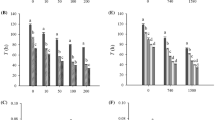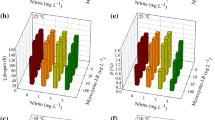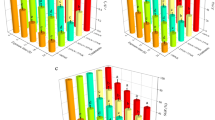Abstract
To investigate the effect of oxidative stress on the survival of two Brachionus species of rotifer, we examined the effective dose of juglone, which generates reactive oxygen species, and compared survival times between the two species. First, we observed that juglone affected survival in the rotifers in a dose-dependent manner between 0.02 to 20 μM, and that treatment at above 2 μM showed acute toxicity causing the animals to die within a few hours. Next, we found the difference in survival time between the two species exposed to 20 μM juglone: B. rotundiformis was significantly more tolerant against the substance than the allied species B. plicatilis. The findings suggest that exploring the basis of species-specific abilities to persist under oxidative stress will be of great interest to uncover the underlying mechanisms governing the stress resistance of the rotifer, as well as contributing to their stable mass production for aquaculture.


Similar content being viewed by others
References
Hagiwara A, Gallardo WG, Assavaaree M, Kotani T, de Araujo AB (2001) Live food production in Japan: recent progress and future aspects. Aquaculture 200:111–127
Yoshinaga T, Kaneko G, Kinoshita S, Tsukamoto K, Watabe S (2003) The molecular mechanisms of life history alterations in a rotifer: a novel approach in population dynamics. Comp Biochem Physiol (B) 136:715–722
Guarente L, Kenyon C (2000) Genetic pathways that regulate ageing in model organisms. Nature 408:255–262
Kaneko G, Yoshinaga T, Kinoshita S, Yanagawa Y, Tsukamoto K, Watabe S (2005) Molecular characterization of Mn-superoxide dismutase and gene expression studies in dietary restricted Brachionus plicatilis rotifers. Hydrobiologia 546:117–123
Yoshinaga T, Kaneko G, Kinoshita S, Furukawa S, Tsukamoto K, Watabe S (2005) Insulin-like signaling pathway may involved in regulating longevity of rotifer. Hydrobiologia 546:347–352
Honda Y, Honda S (1999) The daf-2 gene network for longevity regulates oxidative stress resistance and Mn-superoxide dismutase gene expression in Caenorhabditis elegans. FASEB J 13:1385–1393
Finkel T, Holbrook NJ (2000) Oxidants, oxidative stress and the biology of ageing. Nature 408:239–247
Mallavadhani UV, Panda AK, Rao YR (1998) Pharmacology and chemotaxonomy of Diospyros. Phytochemistry 49:901–951
De Castro E, De Castro SH, Johnson TE (2004) Isolation of long-lived mutants in Caenorhabditis elegans using selection for resistance to juglone. Free Rad Biol Med 37:139–145
Przybysz AJ, Choe KP, Strange K, Roberts LJ (2007) Ageing inhibits the adaptive response of Caenorhabditis elegans to the reactive oxygen species-generating compound juglone. Free Rad Biol Med 43:158
Cypser JR, Johnson TE (2002) Multiple stressors in Caenorhabditis elegans induce stress hormesis and extended longevity. J Gerontol 57:109–114
Kampkötter A, Volkmann TE, de Castro SH, Leiers B, Klotz L-O, Johnson TE, Link CD, Henkle-Dührsen K (2003) Functional analysis of the glutathione S-transferase 3 from Onchocerca volvulus (Ov-GST-3): a parasite GST confers increased resistance to oxidative stress in Caenorhabditis elegans. J Mol Biol 325:25–37
Yoshinaga T, Hagiwara A, Tsukamoto K (1999) Effect of conditioned media on the asexual reproduction of the monogonont rotifer Brachionus plicatilis O. F. Müller. Hydrobiologia 412:103–110
Yoshinaga T, Minegishi Y, Rumengan IFM, Kaneko G, Furukawa S, Yanagawa Y, Tsukamoto K, Watabe S (2004) Molecular phylogeny of the rotifers with two Indonesian Brachionus lineages. Coast Mar Sci 29:45–56
Hennig L, Christner C, Kipping M, Schelbert B, Rucknagel KP, Grabley S, Kullertz G, Fischer G (1998) Selective inactivation of parvulin-like peptidyl-prolyl cist/trans isomerases by juglone. Biochemistry 37:5953–5960
Chao SH, Greenleaf AL, Price DH (2001) Juglone, an inhibitor of the peptidyl-prolyl isomerase Pin1, also directly blocks transcription. Nuc Acids Res 29:767–773
Hagiwara A, Kotani T, Snell TW, Assavaaree M, Hirayama K (1995) Morphology, reproduction, genetics and mating behavior of small, tropical marine rotifer Brachionus strains (Rotifera). J Exp Mar Biol Ecol 194:25–37
Hagiwara A, Suga K, Akazawa A, Kotani T, Sakakura Y (2007) Development of rotifer strains with useful traits for rearing fish larvae. Aquaculture 268:44–52
Gallardo WG, Tomita Y, Hagiwara A, Soyano K, Snell TW (1997) Effect of dimethysulfoxide (DMSO), sodium hydroxide (NaOH), acetone, and ethanol on the population growth, mictic female production, and body size of the rotifer Brachionus plicatilis Muller. Bull Fac Fish Nagasaki Univ 78:15–22
Acknowledgements
The authors wish to thank two anonymous reviewers for their critical reading of our manuscript, and Drs. Atsushi Hagiwara and Koushiro Suga of Nagasaki University for providing the rotifer JS strain. This study was partly supported by a Grant-in-Aid for Young Scientist (A) no. 18688010 from the Ministry of Education, Culture, Sports, and Science and Technology of Japan, and a Research Grant for Young Researchers from the Kitasato University to T.Y.
Author information
Authors and Affiliations
Corresponding author
Rights and permissions
About this article
Cite this article
Tanaka, C., Hashimoto, Y., Nakao, S. et al. Effect of juglone on the survival time of two Brachionus species (Rotifera): species-specific tolerance against oxidative stress. Fish Sci 75, 191–194 (2009). https://doi.org/10.1007/s12562-008-0009-5
Received:
Accepted:
Published:
Issue Date:
DOI: https://doi.org/10.1007/s12562-008-0009-5




